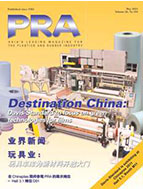 |
 |
E-News Update May 2011 |
LEAD FEATURE |
COMPANY NEWS |
MATERIALS NEWS |
MACHINERY NEWS |
EXHIBITION NEWS |
INJECTION MOULDING ASIA |
PRA May 2011 Electronic Issue Now Available |
Materials News
Microlayer technology increases barrier packaging properties
A
patent-pending technique developed by US-based Extrusion Dies Industries (EDI) is said to extend barrier properties beyond the limits of standard test procedures. Called "active microlayer" technology, it combines active packaging and microlayer extrusion, yielding film and sheet in which layer multiplication is applied not only to the barrier polymer but also to active components such as oxygen absorbers or desiccants.Previous research by EDI has demonstrated that by dividing and recombining the barrier layer to create many micro-barrier layers, it is possible to increase significantly the shelf life of retort and hot-fill containers, stand-up pouches and vacuum skin packaging. Now researchers at EDI have gone a step further by incorporating active components in layers outside the barrier core, then subjecting those components to layer multiplication as well.
The combined protection of food contents by multiple, even dozens, of barrier and active layers appears to be greater than standard tests for oxygen and moisture ingress are designed to measure, according to EDI. It plans to produce samples for a new battery of tests at its technology centre and then have the results confirmed by an outside laboratory.
The company says that after encountering numerous active-component layers, oxygen is largely absorbed before it even reaches the barrier layer, as is moisture before it gets a chance to degrade barrier material such as ethylene-vinyl alcohol (EVOH).
Layer multiplication technology (LMT) yields film or sheet that is no thicker and contains no more polymer than a conventional coextrusion yet can have dozens or even a hundred or more microlayers, instead of the usual three to eleven layers of standard thickness. In conventional coextrusion, a feedblock combines different polymers from two or more extruders into a multilayer sandwich. In LMT, a special tool takes the sandwich from a feedblock and divides and recombines the layers, creating multiples of the original multilayer structure.
In a typical structure to produce PP sheet of 1.25 mm thickness, four extruders would produce melt streams of the PP outer material, or skin; the same PP skin material, but incorporating an active component such as an oxygen scavenger; an adhesive or "tie" layer material; and a barrier polymer such as EVOH. The first feedblock would receive the skin material containing the active component, along with the tie and barrier materials, and form a five-layer sandwich (active component/tie/barrier/tie/active component). This sandwich would evolve into the inner core of the finished sheet.
The layer multiplier would receive the five-layer sandwich from the first feedblock and divide and recombine it to form multiple repetitions of the structure - for example, four repetitions would produce a 20-layer structure of micro-layers. Then a second feedblock would receive this 20-microlayer structure and the melt stream of PP outer material, diverting the PP into two skin layers over the microlayer core. The output from the second feedblock would then pass through the extrusion die to form the sheet of target width.

